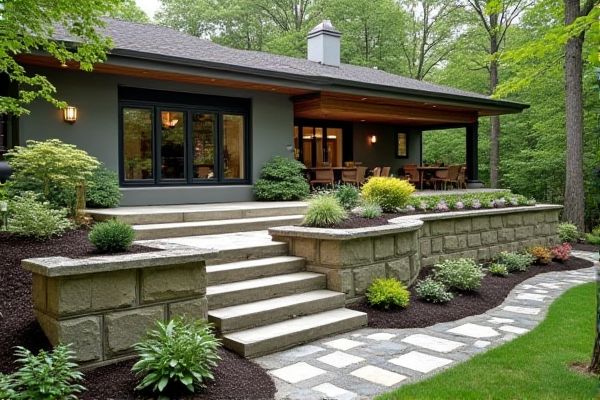
Retaining walls are structural elements designed to hold back soil and prevent erosion, while raised borders primarily serve as decorative garden edging to define spaces without significant load-bearing functions. Understanding the differences in purpose and construction can help you choose the best option for your landscaping needs--read on to explore the pros and cons of each.
Table of Comparison
| Feature | Retaining Wall | Raised Border |
|---|---|---|
| Purpose | Holds back soil, prevents erosion | Defines garden area, contains soil |
| Height | Typically over 3 feet | Usually under 2 feet |
| Structure | Strong, engineered for load-bearing | Simple, decorative or functional |
| Materials | Concrete, stone, brick, timber | Wood, stone, metal, plastic |
| Installation Complexity | Complex, may require permits | Simple, DIY-friendly |
| Cost | High due to materials and labor | Low to moderate |
| Functionality | Prevents soil movement, supports slopes | Enhances aesthetics, keeps plants contained |
| Maintenance | Low to moderate, inspect for damage | Low, occasional cleaning or repair |
Understanding Retaining Walls and Raised Borders
Retaining walls are engineered structures designed to hold back soil and prevent erosion on sloped landscapes, often constructed with concrete, stone, or timber for durability and strength. Raised borders serve as decorative garden edges that slightly elevate planting areas to improve soil drainage and define space, typically made from wood, bricks, or metal. Understanding the differences helps you choose the right option for stability needs versus aesthetic enhancement in your outdoor space.
Key Differences Between Retaining Walls and Raised Borders
Retaining walls are structural elements engineered to hold back soil and prevent erosion, often made from concrete, stone, or timber, and designed to withstand significant lateral pressure. Raised borders, by contrast, are decorative garden features that elevate planting areas without the primary function of soil retention, typically constructed with bricks, wood, or metal edging. The key difference lies in their purpose and strength: retaining walls provide essential earth support and stability, while raised borders mainly serve aesthetic and minor containment roles.
Structural Purpose and Functionality
Retaining walls are engineered structures designed to hold back soil and prevent erosion, providing critical support for sloped landscapes and preventing land movement. Raised borders serve primarily as decorative edging for garden beds, helping to contain mulch or plants but lacking the strength to withstand significant lateral soil pressure. Understanding your project's structural needs will help determine if a retaining wall's load-bearing capability or a raised border's aesthetic boundary is more suitable for your outdoor space.
Materials Used for Retaining Walls vs Raised Borders
Retaining walls commonly utilize durable materials such as concrete blocks, natural stone, treated timber, and reinforced masonry to withstand soil pressure and environmental stress. Raised borders often feature lighter, decorative materials like brick, wood planks, metal edging, or plastic composites designed primarily for garden aesthetics and minor soil containment. The choice of materials directly impacts the structure's strength, longevity, and intended function in landscape design.
Installation Complexity and Cost Comparison
Retaining walls typically involve higher installation complexity due to the need for proper drainage systems, foundation preparation, and skilled labor, which results in increased costs compared to raised borders. Raised borders are simpler to install, often requiring minimal groundwork and basic materials, making them a budget-friendly option for defining garden spaces. Your choice depends on the landscape requirements and budget, with retaining walls providing structural support and raised borders offering aesthetic edging at a lower price point.
Aesthetic Impact on Landscape Design
Retaining walls create a bold, structured element that adds height and depth to your landscape, offering both functional support and a visually striking design feature. Raised borders provide subtle elevation changes, enhancing garden beds with a softer, more natural appearance that blends seamlessly with surrounding plants. Choosing between the two depends on the desired aesthetic impact: retaining walls emphasize strong lines and architectural detail, while raised borders promote organic flow and gentle transitions.
Soil Retention and Drainage Considerations
Retaining walls provide superior soil retention by supporting significant earth pressure and preventing soil erosion on sloped terrains. Raised borders offer limited soil stability, mainly suitable for small garden beds with minimal soil displacement. Effective drainage in retaining walls is achieved through integrated systems like weep holes and gravel backfill, reducing hydrostatic pressure, whereas raised borders typically rely on surface drainage without specialized moisture management.
Maintenance Requirements and Longevity
Retaining walls typically require less frequent maintenance than raised borders due to their solid construction and ability to manage soil erosion effectively, often lasting decades with proper installation. Raised borders, while easier to adjust or move, may need more regular upkeep such as repainting or treating for weather damage and generally have a shorter lifespan. Choosing the right option depends on your long-term garden goals and willingness to commit to maintenance routines.
Choosing the Right Option for Your Garden
Retaining walls are ideal for managing significant soil erosion and creating level planting areas on sloped terrain. Raised borders provide a more decorative, manageable height for garden beds, enhancing accessibility and soil control without extensive construction. Selecting the right option depends on the garden's slope degree, desired aesthetic, and soil retention needs.
Environmental and Safety Factors
Retaining walls provide superior erosion control and soil stabilization, crucial for preventing landslides and managing water runoff in sloped landscapes, thereby enhancing environmental sustainability. Raised borders offer less structural support but promote biodiversity by allowing better water permeability and root aeration, reducing soil compaction. Safety considerations favor retaining walls as they serve as robust barriers to prevent accidental falls or soil collapse, especially in areas with significant elevation changes.
 homyna.com
homyna.com